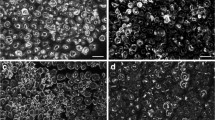Abstract
This document presents the guidelines for anti-myelin-associated glycoprotein (MAG) antibody testing that have been developed following a consensus process built on questionnaire-based surveys, internet contacts, and discussions at workshops of sponsoring Italian Association of Neuroimmunology (AINI) congresses. The main clinical information on anti-MAG antibody polyneuropathy, indications and limits of anti-MAG antibody testing, instructions for result interpretation, and an agreed laboratory protocol (Appendix) are reported for the communicative community of neurologists and clinical pathologists.

Similar content being viewed by others
References
Talamo G, Mir MA, Pandey MK, Sivik JK, Raheja D (2015) IgM MGUS associated with anti-MAG neuropathy: a single institution experience. Ann Hematol 94:1011–1016
Nobile-Orazio E, Manfredini E, Carpo M et al (1994) Frequency and clinical correlates of anti-neural IgM antibodies in neuropathy associated with IgM monoclonal gammopathy. Ann Neurol 36:416–424
Nobile-Orazio E, Gallia F, Terenghi F, Allaria S, Giannotta C, Carpo M (2008) How useful are anti-neural IgM antibodies in the diagnosis of chronic immune-mediated neuropathies? J Neurol Sci 266:156–163
Latov N, Sherman WH, Nemni R (1980) Plasma-cell dyscrasia and peripheral neuropathy with a monoclonal antibody to peripheral-nerve myelin. N Engl J Med 303:618–621
Rajabally YA (2011) Neuropathy and paraproteins: review of a complex association. Eur J Neurol 18:1291–1298
Hadden RD, Nobile-Orazio E, Sommer CL (2010) European Federation of Neurological Societies/peripheral nerve society guideline on management of paraproteinemic demyelinating neuropathies. Report of a Joint Task Force of the European Federation of Neurological Societies and the Peripheral Nerve Society--first revision. J Peripher Nerv Syst 15:185–195
Lunn MP, Nobile-Orazio E (2016) Immunotherapy for IgM anti-myelin-associated glycoprotein paraprotein-associated peripheral neuropathies. Cochrane Database Syst Rev 10:CD002827
Caudie C, Vial C, Petiot P, Bancel J, Lombard C, Gonnaud PM (2001) Monoclonal IgM autoantibody activity vis-à-vis glycoconjugates of peripheral nerves: apropos of 112 cases. Ann Biol Clin 59:567–577
Nobile-Orazio E, Latov N, Hays AP et al (1984) Neuropathy and anti-MAG antibodies without detectable serum M-protein. Neurology 34:218–221
Kuijf ML, Eurelings M, Tio-Gillen AP et al (2009) Detection of anti-MAG antibodies in polyneuropathy associated with IgM monoclonal gammopathy. Neurology 73:688–695
Caudie C, Kaygisiz F, Jaquet P, Petiot P, Gonnaud PM, Antoine JC, Vial C (2006) Diagnostic value of autoantibodies to MAG by ELISA Bühlmann in 117 immune-mediated peripheral neuropathies associated with monoclonal IgM to SGPG/SGLPG. Ann Biol Clin 64:353–359
Obuchowski NA, Lieber ML, Wians FH Jr (2004) ROC curves in clinical chemistry: uses, misuses, and possible solutions. Clin Chem 50:1118–1125
Author information
Authors and Affiliations
Corresponding author
Ethics declarations
Conflict of interest
The authors declare that they have no conflict of interest.
Appendices
Appendix
Preanalytical procedures
Refer to the document on “diagnostics of autoimmune encephalitis associated with antibodies against neuronal surface antigens.”
Analytical procedures
ELISA
The herein described analytical procedures refer to the certified commercial anti-MAG IgM ELISA currently used by the AINI centers (Bühlmann, Schönenbuch, Switzerland).
Reagent preparation
Dilute the concentrated buffer solution with deionized water (1:10) (about 80 mL per strip). Use the diluted buffer cooled (put the beaker on ice).
Reconstitute the four calibrators (anti-MAG antibody concentrations: 70,000, 15,000, 3000, and 1000 BTU). Store in aliquots at −20 °C for up to 2 months.
Controls and samples
Reconstitute the two controls with incubation buffer (1 mL). Store in aliquots at −20 °C for up to 2 months.
Dilute sera with incubation buffer (1:1000). Let the diluted samples rest for 1 h at 18–28 °C, vortexing from time to time. Put the sample tubes on ice for 10 min before dispensing.
Procedure
Take the strips needed to test the samples and immediately seal the remaining ones in the original envelope.
Wash the pre-coated microwells four times with 300 μL/well of the cooled washing solution.
Empty the wells and tap the microplate onto absorbent paper sheets to completely remove the liquid.
Pipet four calibrators, two controls, and samples in duplicate (100 μL/well).
Cover the microplate with a sealing sheet and incubate for 2 h (±5 min) at 2–8 °C.
Empty the wells, and wash and empty them as above described.
Add peroxidase-conjugated anti-human IgM (100 μL/well), cover with a sealing sheet and incubate for 2 h (±5 min) at 2-8°C.
Empty the wells, and wash and empty them as above described.
Important: Let the substrate solution reach the temperature of 18–28 °C.
Add substrate solution (100 μL/well).
Cover the microplate with a sealing sheet, put it onto a plate mixer at 800–1000 rpm, protect from light, and incubate for 30 min (±5 min) at 18–28 °C.
Add stopping solution (100 μL/well). Take care of getting rid of air bubbles. Read the microplate by 30 min.
Read absorbances at 450 nm using a microplate ELISA reader (if available, set the instrument doubling the wavelengths at 450 nm and at 600/620 nm to minimize background).
Result interpretation
Design standard curves by placing absorbance values (OD) on the vertical axis and BTU values on the horizontal axis for each calibrator (mean values). Absorbances are proportional to anti-MAG antibody titers (expressed in arbitrary units, BTU). If the microplate reader cannot read OD >2.0 read at 490/492 nm wavelengths (reference filters, 600/620 nm).
Serum samples with BTU values ≤1000 are “negative,” those with BTU values ≥10,000 “positive,” and those with BTU values between 1000 and 10,000 “weak positive” or “negative” on the basis of what reported in “clinical and laboratory aspects” section of this document.
Quality control and sample storage
Refer to the document on “diagnostics of the neuromyelitis optica spectrum disorders (NMOSD).”
Report
A qualitative result (positive/negative/weak positive) should be reported, along with the BTU value.
The report should contain the following general information:
-
i)
Type of method (ELISA) and name of the kit manufacturer.
-
ii)
Reference values: report the cutoff of positivity.
-
iii)
Comments: refer to the document on “cerebrospinal fluid analysis and the determination of oligoclonal bands.”
Rights and permissions
About this article
Cite this article
Franciotta, D., Gastaldi, M., Benedetti, L. et al. Diagnostics of anti-MAG antibody polyneuropathy. Neurol Sci 38 (Suppl 2), 249–252 (2017). https://doi.org/10.1007/s10072-017-3024-4
Published:
Issue Date:
DOI: https://doi.org/10.1007/s10072-017-3024-4




